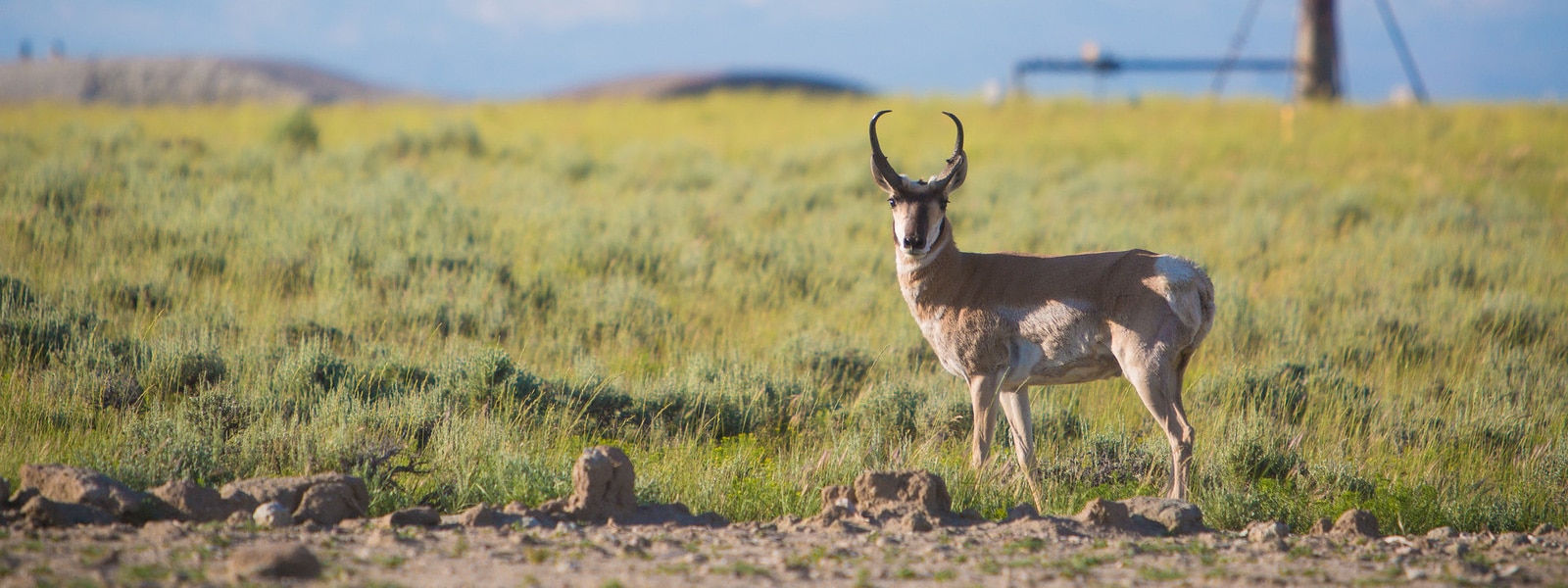Sage-Grouse
Greater Sage-Grouse populations declined over the past century prompting consideration for the bird to be listed under the Endangered Species Act. As the epicenter of sage grouse habitat, the State of Wyoming took a proactive approach to providing protection for Greater Sage-Grouse and their habitat. In coordination with the oil and gas industry and other stakeholders, Wyoming developed the unique and envied Wyoming Core Area Strategy. The strategy prioritizes prime Sage-Grouse habitat and populations and encourages resource development in other areas. The strategy also takes a scientific approach to disturbance in order to allow development where impacts are minimal, and avoid development where impacts are great.
To ensure the long-term viability of the strategy, Wyoming formed the Sage-Grouse Implementation Team (SGIT) as the stakeholder group that makes recommendations to the Governor regarding regulatory actions to conserve sage-grouse and protect their habitat from threats.
The oil and natural gas industry understands the importance of efforts to protect Sage-Grouse and has consistently adhered to state and federal policies aimed at conserving the species. For example, oil and gas activity comes to a halt during critical times of year for the Sage-Grouse to support their reproductive viability. Industry also continues to be an active member of the SGIT and is especially conscious of how activities are conducted in core population areas which consist of the best Sage-Grouse habitat in the Wyoming.
Migration Corridors
Hunting in Wyoming is both a way of life and an important segment of the state’s economy. Many Wyoming residents working in the oil and gas industry are avid hunters and have a vested interest in protecting the viability of big game herds. New knowledge of the importance of migration corridors to Wyoming’s ungulates prompted the Wyoming Game and Fish Department to create an Ungulate Migration Corridor Strategy in 2016 which includes the step-by-step process for the formal designation of migration corridors. The Strategy was developed in coordination with various stakeholders, including conservation groups and the oil and gas industry, as a way to manage activities and development located in migration corridors on a project-specific basis through avoidance and minimization.
The oil and gas industry understands the importance of wildlife to the state and believes protection of migration corridor functionality is necessary. The science is not clear on how different species of large ungulates migrate, and what level of impacts negatively affect their movements. More data is necessary to clearly understand these issues, and work is still being conducted in this field. In the meantime, oil and gas operators continue to be actively involved with the state and stakeholders as policies are developed to ensure that wildlife remain viable and vibrant, and prudent development can occur.
Hydraulic Fracturing (Fracking)
Hydraulic fracturing (also referred to as frac’ing or fracking) is a completion technique used in tight geologic formations to better access oil and gas reserves. The process involves pumping fluid, made up of mostly water and sand, into the target formation, thereby creating small fractures in the rock that enable hydrocarbons to flow to the wellbore.
Fracking is a wonder of technological advancement pioneered by scientists in the oil and gas industry. It has unlocked America’s oil and gas resource and freed Americans from the grip of Middle East oil oligarchs. Innovations like this are what keeps energy prices so low that we in America take it for granted.
In Wyoming, a model state for fracking regulations, the oil and gas industry is required to test water sources within half a mile of a rig site before commencing with hydraulic fracturing. This baseline testing helps determine if any hydrocarbons have migrated later in the process. Companies are also required to disclose the chemical makeup of fracking fluids to the Wyoming Oil and Gas Conservation Commission. Wyoming was the first state to require this disclosure.
The oil and gas industry in Wyoming believes in operating safely – for its employees, the public, and the environment – while providing the resources to power Wyoming and the world.
Climate Change
The Petroleum Association of Wyoming (PAW) is the voice of the oil and natural gas industry: Wyoming’s primary economic engine. PAW members foster the human experience by producing, transporting, and refining safe, dependable, affordable products and energy needed in Wyoming and across the globe. The oil and natural gas industry is indispensable to Wyoming’s economy, and conserving Wyoming’s pristine natural resources is indispensable to our core values. As such our members place environmental responsibility, safety, and sustainability at the forefront as they meet the energy needs of our world – now and into the future.
PAW members are committed to continuous innovation, technological advancement, and a collaborative approach to addressing climate change. PAW recognizes that solving the challenge of an evolving climate is a global effort that will require shared responsibility and participation across industries, regions, and peoples.
As one of the largest producer of petroleum products from federal land in the United States, Wyoming has an important role to play in climate solutions. As home to some of the most regulated production in the world – production mostly exported for others to consume – Wyoming’s industry already develops the cleanest resources available and is furthering environmental progress every day.
PAW members are poised to provide the energy required to fuel our shared desire for a better life. We support an approach that recognizes the need for oil and natural gas while balancing national security, environmental responsibility, economic growth, and a commitment to our communities across Wyoming.
There is no solution to climate change without oil and gas. There is no just solution without Wyoming.
